The Impact of Prospect Theory on Finance and Investment Behaviour
VerifiedAdded on 2020/12/09
|14
|3717
|62
Report
AI Summary
This report delves into the realm of investment behavior, utilizing prospect theory as its core framework to analyze how individuals make financial decisions under uncertainty. It begins with an introduction to the concept, highlighting the role of asymmetrical information and the importance of prospect theory in predicting decisions involving risk. The report's aim is to assess the predictive power of prospect theory, specifically examining the impact of loss aversion on individual behavior. The objectives include assessing individual preferences in risky monetary outcomes, evaluating the utility derived from investment strategies, and identifying areas for further research. The literature review explores individual preferences in risky monetary outcomes, the utility derived from money strategies, and areas for better research, drawing upon the works of various scholars. The methodology involves the use of questionnaires and quantitative analysis using SPSS software. The findings and conclusions of the report provide insights into how loss aversion affects investment decisions, with recommendations for improving financial choices. The report also covers concepts like expected utility, heuristics, behavioral bias, and loss aversion in detail. The conclusion summarizes the key findings and provides recommendations for enhancing investment strategies.
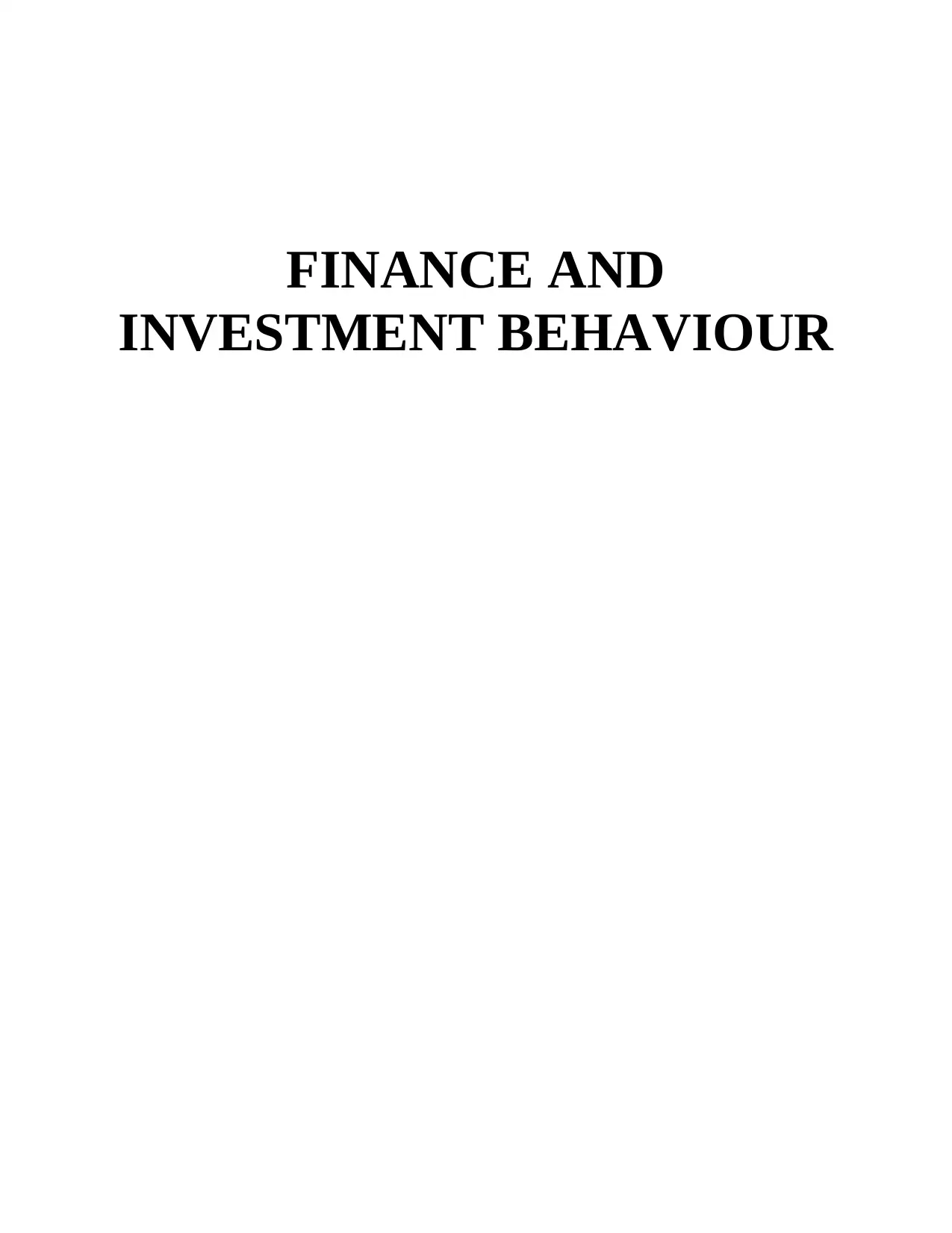
FINANCE AND
INVESTMENT BEHAVIOUR
INVESTMENT BEHAVIOUR
Paraphrase This Document
Need a fresh take? Get an instant paraphrase of this document with our AI Paraphraser
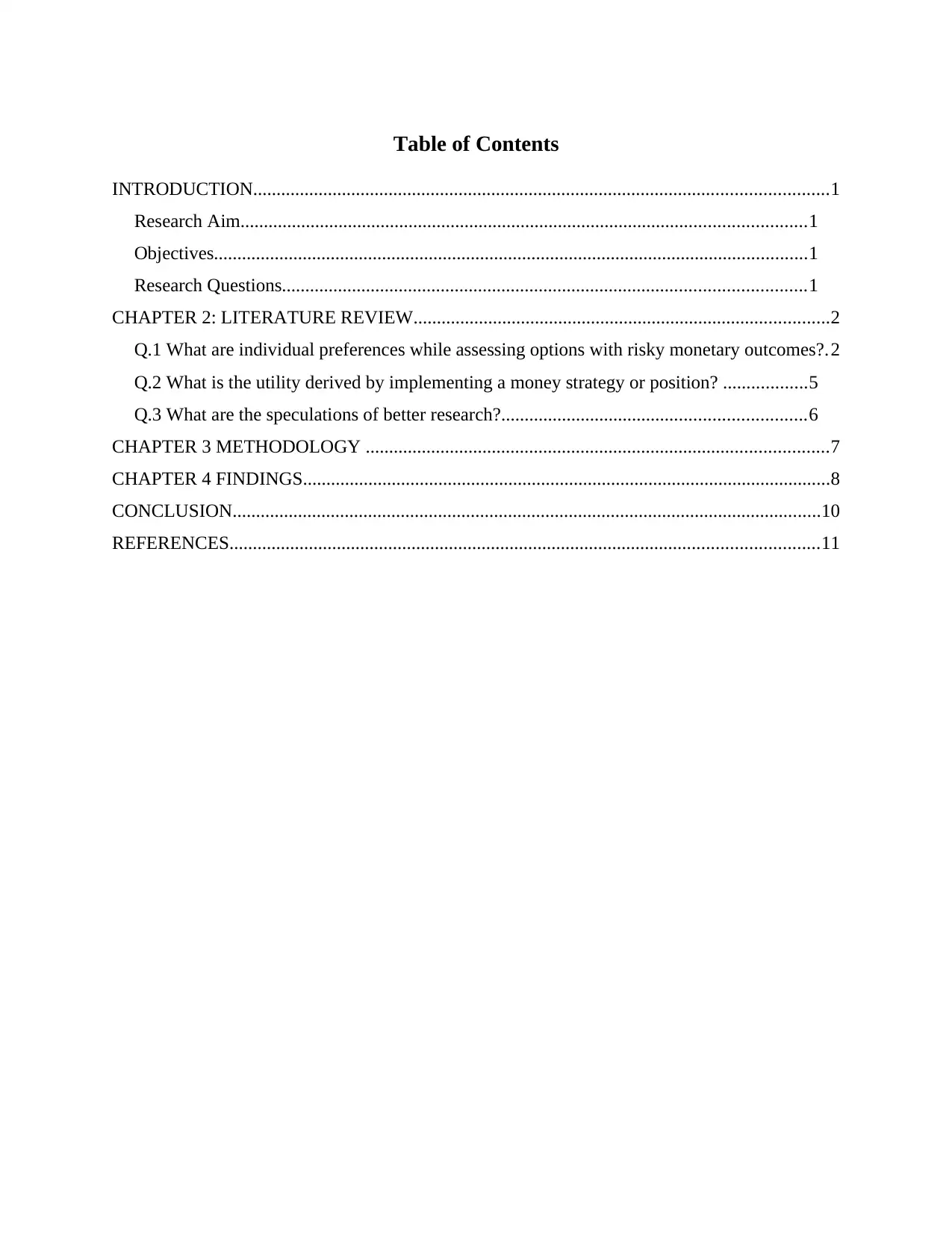
Table of Contents
INTRODUCTION...........................................................................................................................1
Research Aim.........................................................................................................................1
Objectives...............................................................................................................................1
Research Questions................................................................................................................1
CHAPTER 2: LITERATURE REVIEW.........................................................................................2
Q.1 What are individual preferences while assessing options with risky monetary outcomes?.2
Q.2 What is the utility derived by implementing a money strategy or position? ..................5
Q.3 What are the speculations of better research?.................................................................6
CHAPTER 3 METHODOLOGY ...................................................................................................7
CHAPTER 4 FINDINGS.................................................................................................................8
CONCLUSION..............................................................................................................................10
REFERENCES..............................................................................................................................11
INTRODUCTION...........................................................................................................................1
Research Aim.........................................................................................................................1
Objectives...............................................................................................................................1
Research Questions................................................................................................................1
CHAPTER 2: LITERATURE REVIEW.........................................................................................2
Q.1 What are individual preferences while assessing options with risky monetary outcomes?.2
Q.2 What is the utility derived by implementing a money strategy or position? ..................5
Q.3 What are the speculations of better research?.................................................................6
CHAPTER 3 METHODOLOGY ...................................................................................................7
CHAPTER 4 FINDINGS.................................................................................................................8
CONCLUSION..............................................................................................................................10
REFERENCES..............................................................................................................................11
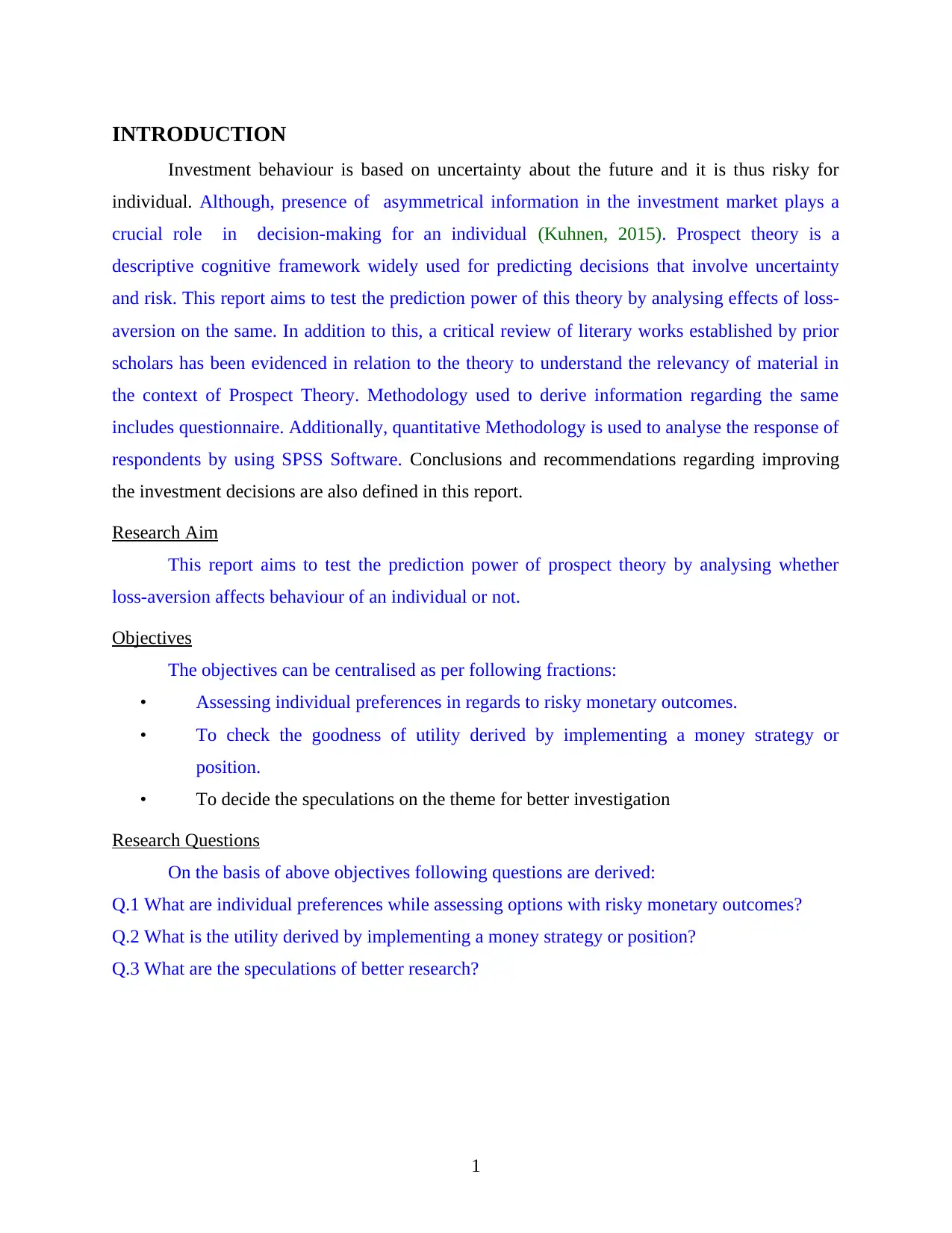
INTRODUCTION
Investment behaviour is based on uncertainty about the future and it is thus risky for
individual. Although, presence of asymmetrical information in the investment market plays a
crucial role in decision-making for an individual (Kuhnen, 2015). Prospect theory is a
descriptive cognitive framework widely used for predicting decisions that involve uncertainty
and risk. This report aims to test the prediction power of this theory by analysing effects of loss-
aversion on the same. In addition to this, a critical review of literary works established by prior
scholars has been evidenced in relation to the theory to understand the relevancy of material in
the context of Prospect Theory. Methodology used to derive information regarding the same
includes questionnaire. Additionally, quantitative Methodology is used to analyse the response of
respondents by using SPSS Software. Conclusions and recommendations regarding improving
the investment decisions are also defined in this report.
Research Aim
This report aims to test the prediction power of prospect theory by analysing whether
loss-aversion affects behaviour of an individual or not.
Objectives
The objectives can be centralised as per following fractions:
• Assessing individual preferences in regards to risky monetary outcomes.
• To check the goodness of utility derived by implementing a money strategy or
position.
• To decide the speculations on the theme for better investigation
Research Questions
On the basis of above objectives following questions are derived:
Q.1 What are individual preferences while assessing options with risky monetary outcomes?
Q.2 What is the utility derived by implementing a money strategy or position?
Q.3 What are the speculations of better research?
1
Investment behaviour is based on uncertainty about the future and it is thus risky for
individual. Although, presence of asymmetrical information in the investment market plays a
crucial role in decision-making for an individual (Kuhnen, 2015). Prospect theory is a
descriptive cognitive framework widely used for predicting decisions that involve uncertainty
and risk. This report aims to test the prediction power of this theory by analysing effects of loss-
aversion on the same. In addition to this, a critical review of literary works established by prior
scholars has been evidenced in relation to the theory to understand the relevancy of material in
the context of Prospect Theory. Methodology used to derive information regarding the same
includes questionnaire. Additionally, quantitative Methodology is used to analyse the response of
respondents by using SPSS Software. Conclusions and recommendations regarding improving
the investment decisions are also defined in this report.
Research Aim
This report aims to test the prediction power of prospect theory by analysing whether
loss-aversion affects behaviour of an individual or not.
Objectives
The objectives can be centralised as per following fractions:
• Assessing individual preferences in regards to risky monetary outcomes.
• To check the goodness of utility derived by implementing a money strategy or
position.
• To decide the speculations on the theme for better investigation
Research Questions
On the basis of above objectives following questions are derived:
Q.1 What are individual preferences while assessing options with risky monetary outcomes?
Q.2 What is the utility derived by implementing a money strategy or position?
Q.3 What are the speculations of better research?
1
⊘ This is a preview!⊘
Do you want full access?
Subscribe today to unlock all pages.

Trusted by 1+ million students worldwide
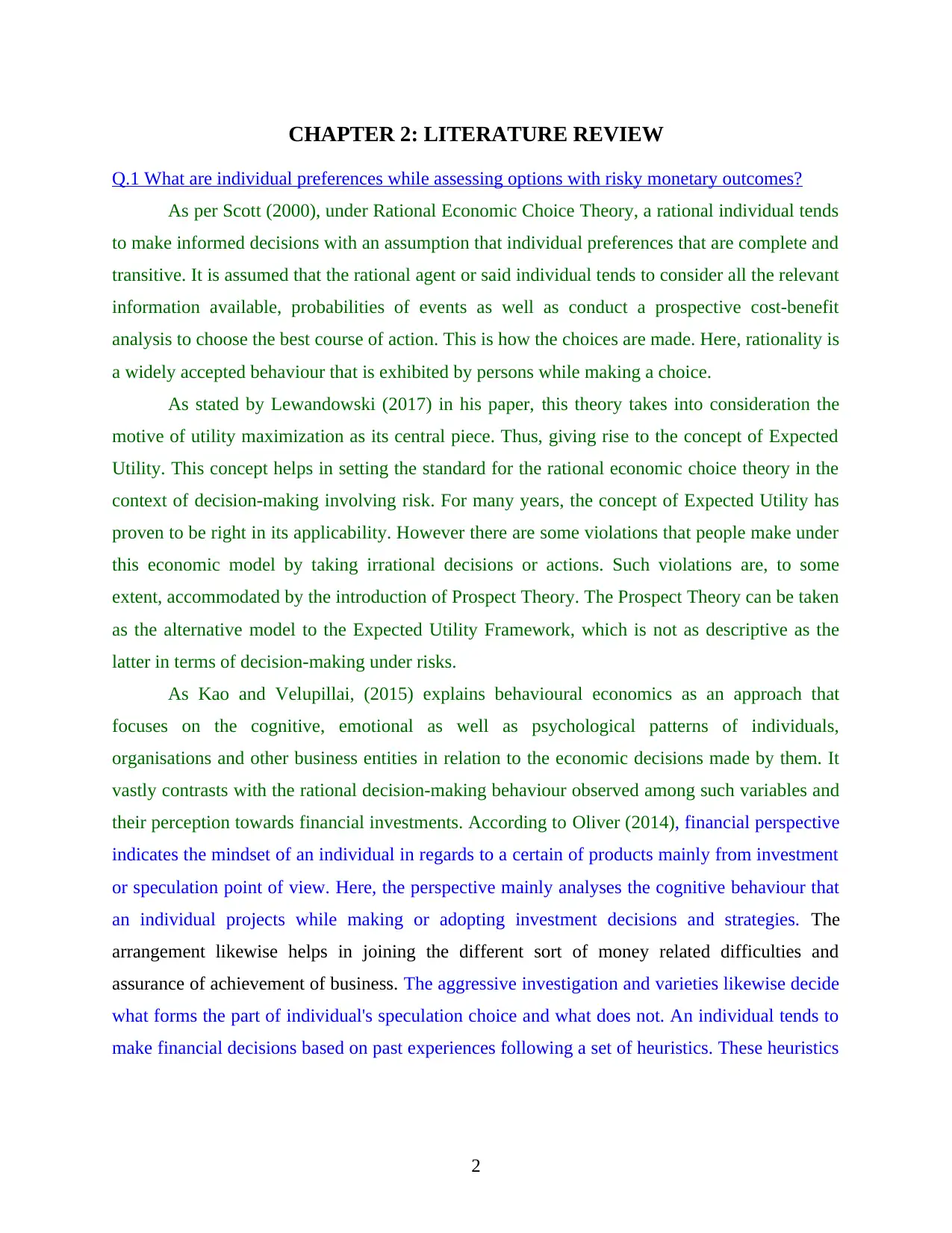
CHAPTER 2: LITERATURE REVIEW
Q.1 What are individual preferences while assessing options with risky monetary outcomes?
As per Scott (2000), under Rational Economic Choice Theory, a rational individual tends
to make informed decisions with an assumption that individual preferences that are complete and
transitive. It is assumed that the rational agent or said individual tends to consider all the relevant
information available, probabilities of events as well as conduct a prospective cost-benefit
analysis to choose the best course of action. This is how the choices are made. Here, rationality is
a widely accepted behaviour that is exhibited by persons while making a choice.
As stated by Lewandowski (2017) in his paper, this theory takes into consideration the
motive of utility maximization as its central piece. Thus, giving rise to the concept of Expected
Utility. This concept helps in setting the standard for the rational economic choice theory in the
context of decision-making involving risk. For many years, the concept of Expected Utility has
proven to be right in its applicability. However there are some violations that people make under
this economic model by taking irrational decisions or actions. Such violations are, to some
extent, accommodated by the introduction of Prospect Theory. The Prospect Theory can be taken
as the alternative model to the Expected Utility Framework, which is not as descriptive as the
latter in terms of decision-making under risks.
As Kao and Velupillai, (2015) explains behavioural economics as an approach that
focuses on the cognitive, emotional as well as psychological patterns of individuals,
organisations and other business entities in relation to the economic decisions made by them. It
vastly contrasts with the rational decision-making behaviour observed among such variables and
their perception towards financial investments. According to Oliver (2014), financial perspective
indicates the mindset of an individual in regards to a certain of products mainly from investment
or speculation point of view. Here, the perspective mainly analyses the cognitive behaviour that
an individual projects while making or adopting investment decisions and strategies. The
arrangement likewise helps in joining the different sort of money related difficulties and
assurance of achievement of business. The aggressive investigation and varieties likewise decide
what forms the part of individual's speculation choice and what does not. An individual tends to
make financial decisions based on past experiences following a set of heuristics. These heuristics
2
Q.1 What are individual preferences while assessing options with risky monetary outcomes?
As per Scott (2000), under Rational Economic Choice Theory, a rational individual tends
to make informed decisions with an assumption that individual preferences that are complete and
transitive. It is assumed that the rational agent or said individual tends to consider all the relevant
information available, probabilities of events as well as conduct a prospective cost-benefit
analysis to choose the best course of action. This is how the choices are made. Here, rationality is
a widely accepted behaviour that is exhibited by persons while making a choice.
As stated by Lewandowski (2017) in his paper, this theory takes into consideration the
motive of utility maximization as its central piece. Thus, giving rise to the concept of Expected
Utility. This concept helps in setting the standard for the rational economic choice theory in the
context of decision-making involving risk. For many years, the concept of Expected Utility has
proven to be right in its applicability. However there are some violations that people make under
this economic model by taking irrational decisions or actions. Such violations are, to some
extent, accommodated by the introduction of Prospect Theory. The Prospect Theory can be taken
as the alternative model to the Expected Utility Framework, which is not as descriptive as the
latter in terms of decision-making under risks.
As Kao and Velupillai, (2015) explains behavioural economics as an approach that
focuses on the cognitive, emotional as well as psychological patterns of individuals,
organisations and other business entities in relation to the economic decisions made by them. It
vastly contrasts with the rational decision-making behaviour observed among such variables and
their perception towards financial investments. According to Oliver (2014), financial perspective
indicates the mindset of an individual in regards to a certain of products mainly from investment
or speculation point of view. Here, the perspective mainly analyses the cognitive behaviour that
an individual projects while making or adopting investment decisions and strategies. The
arrangement likewise helps in joining the different sort of money related difficulties and
assurance of achievement of business. The aggressive investigation and varieties likewise decide
what forms the part of individual's speculation choice and what does not. An individual tends to
make financial decisions based on past experiences following a set of heuristics. These heuristics
2
Paraphrase This Document
Need a fresh take? Get an instant paraphrase of this document with our AI Paraphraser
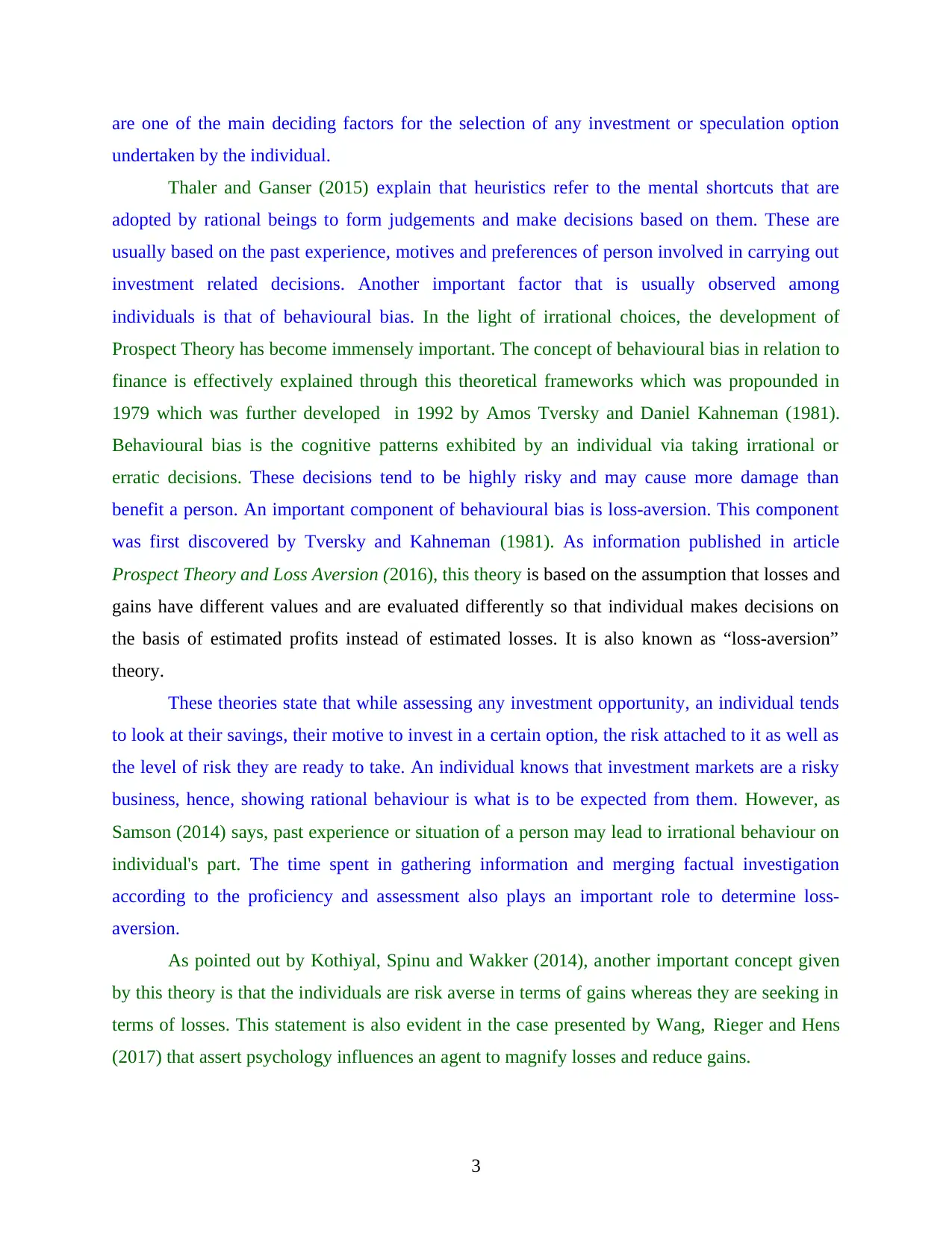
are one of the main deciding factors for the selection of any investment or speculation option
undertaken by the individual.
Thaler and Ganser (2015) explain that heuristics refer to the mental shortcuts that are
adopted by rational beings to form judgements and make decisions based on them. These are
usually based on the past experience, motives and preferences of person involved in carrying out
investment related decisions. Another important factor that is usually observed among
individuals is that of behavioural bias. In the light of irrational choices, the development of
Prospect Theory has become immensely important. The concept of behavioural bias in relation to
finance is effectively explained through this theoretical frameworks which was propounded in
1979 which was further developed in 1992 by Amos Tversky and Daniel Kahneman (1981).
Behavioural bias is the cognitive patterns exhibited by an individual via taking irrational or
erratic decisions. These decisions tend to be highly risky and may cause more damage than
benefit a person. An important component of behavioural bias is loss-aversion. This component
was first discovered by Tversky and Kahneman (1981). As information published in article
Prospect Theory and Loss Aversion (2016), this theory is based on the assumption that losses and
gains have different values and are evaluated differently so that individual makes decisions on
the basis of estimated profits instead of estimated losses. It is also known as “loss-aversion”
theory.
These theories state that while assessing any investment opportunity, an individual tends
to look at their savings, their motive to invest in a certain option, the risk attached to it as well as
the level of risk they are ready to take. An individual knows that investment markets are a risky
business, hence, showing rational behaviour is what is to be expected from them. However, as
Samson (2014) says, past experience or situation of a person may lead to irrational behaviour on
individual's part. The time spent in gathering information and merging factual investigation
according to the proficiency and assessment also plays an important role to determine loss-
aversion.
As pointed out by Kothiyal, Spinu and Wakker (2014), another important concept given
by this theory is that the individuals are risk averse in terms of gains whereas they are seeking in
terms of losses. This statement is also evident in the case presented by Wang, Rieger and Hens
(2017) that assert psychology influences an agent to magnify losses and reduce gains.
3
undertaken by the individual.
Thaler and Ganser (2015) explain that heuristics refer to the mental shortcuts that are
adopted by rational beings to form judgements and make decisions based on them. These are
usually based on the past experience, motives and preferences of person involved in carrying out
investment related decisions. Another important factor that is usually observed among
individuals is that of behavioural bias. In the light of irrational choices, the development of
Prospect Theory has become immensely important. The concept of behavioural bias in relation to
finance is effectively explained through this theoretical frameworks which was propounded in
1979 which was further developed in 1992 by Amos Tversky and Daniel Kahneman (1981).
Behavioural bias is the cognitive patterns exhibited by an individual via taking irrational or
erratic decisions. These decisions tend to be highly risky and may cause more damage than
benefit a person. An important component of behavioural bias is loss-aversion. This component
was first discovered by Tversky and Kahneman (1981). As information published in article
Prospect Theory and Loss Aversion (2016), this theory is based on the assumption that losses and
gains have different values and are evaluated differently so that individual makes decisions on
the basis of estimated profits instead of estimated losses. It is also known as “loss-aversion”
theory.
These theories state that while assessing any investment opportunity, an individual tends
to look at their savings, their motive to invest in a certain option, the risk attached to it as well as
the level of risk they are ready to take. An individual knows that investment markets are a risky
business, hence, showing rational behaviour is what is to be expected from them. However, as
Samson (2014) says, past experience or situation of a person may lead to irrational behaviour on
individual's part. The time spent in gathering information and merging factual investigation
according to the proficiency and assessment also plays an important role to determine loss-
aversion.
As pointed out by Kothiyal, Spinu and Wakker (2014), another important concept given
by this theory is that the individuals are risk averse in terms of gains whereas they are seeking in
terms of losses. This statement is also evident in the case presented by Wang, Rieger and Hens
(2017) that assert psychology influences an agent to magnify losses and reduce gains.
3

As Kahneman and Tversky (2013) point out that under this theory gains and losses can
be expressed in the form of positive and negative outcomes. However, there tends to be a neutral
point with an assigned value of zero known as 'Reference Point'. The Value Function tends to be
convex below this point and concave above. They stated that the difference in subjective values
between gains of $10 and $20 is greater than the subjective difference between gains of $110 and
$120. The same relation between value differences holds for the corresponding losses. The paper
also stated another property which has been repeatedly undertaken in this review is that response
to losses is more adverse as compared to that of gains. This is due to the dissatisfaction felt by
agents when incurring a loss. Another example of this can be demonstrated in gambling or
betting.
Kahneman and Tversky (2013) explain that the loss aversion can be derived from the
value function graph by assuming that the gains derived from accepting a choice are there
advantages and their disadvantages as losses. Since a decision-maker is biased, the person would
make sure to maintain the status-quo. The reference point here can be taken as a riskless choice
point for a decision maker where no loss or gain is derived. Explained in the article Introduction
4
be expressed in the form of positive and negative outcomes. However, there tends to be a neutral
point with an assigned value of zero known as 'Reference Point'. The Value Function tends to be
convex below this point and concave above. They stated that the difference in subjective values
between gains of $10 and $20 is greater than the subjective difference between gains of $110 and
$120. The same relation between value differences holds for the corresponding losses. The paper
also stated another property which has been repeatedly undertaken in this review is that response
to losses is more adverse as compared to that of gains. This is due to the dissatisfaction felt by
agents when incurring a loss. Another example of this can be demonstrated in gambling or
betting.
Kahneman and Tversky (2013) explain that the loss aversion can be derived from the
value function graph by assuming that the gains derived from accepting a choice are there
advantages and their disadvantages as losses. Since a decision-maker is biased, the person would
make sure to maintain the status-quo. The reference point here can be taken as a riskless choice
point for a decision maker where no loss or gain is derived. Explained in the article Introduction
4
⊘ This is a preview!⊘
Do you want full access?
Subscribe today to unlock all pages.

Trusted by 1+ million students worldwide

to Prospect Theory by John Miyamoto (2017), it is noteworthy that the risk aversion and risk
seeking frames apply to gains and losses but not the states of wealth. Hence, when the utility
function is highly concave it indicates the risk averse tendency of the decision-maker while c
This is a repetitive and repetitive process that is executed until the threat of loss equals any
incurred gains. Instances of such patterns can be found through endowment effect and sunk cost
fallacy.
Chang (2019) states that endowment effect is a bias which asserts that individuals tend to
prioritise those goods or financial products that owned by them rather than ones that are identical
or not owned by them altogether .According to Frame and White (2014), Sunk Cost Fallacy bias
is a result of an ongoing commitment which is difficult to be abandoned. This factor examines
the imbalances made in minds of individual about losses and gains. Hammond, Keeney and
Raiffa (2015) assert that the more urgent a person is to avoid threats in regards to an investment
decision, the more likely they are to be motivated to make cautious decisions ensuring gains.
Hence, loss-aversion is an important factor that analyses pay-off between potential gains and
losses.
Q.2 What is the utility derived by implementing a money strategy or position?
An investment strategy adopted by the individual is of no use if they are not able to
derive gains more than the risk undertaken by them. In general, the models mainly helps in
creating the effective analysis and control with managing the proper information of cash flow
information. Loss aversion also analyses the theoretical and political evaluation and control with
different different opportunities for various labels. It also helps in determination of the flexibility
in overcomes by looking at considerable changes. The utility here is measured in the terms of
gains incurred and losses avoided or averted by making a financial decision.
Here, Prospect theory will apply, when an individual has two alternatives, one which are
equal, and other one being presented in terms of prospective gains and possible losses. As
explained by John Miyamoto (2017) in the previous research question, value function can help
determine the situation of loss aversion when the gains are treated as advantages. Here, the
reflection effect is treated as the concluding inference or result under which circumstance, there
is high preference given to to switching from risk averse to risk seeking, especially when the
losses and gains are deemed to be dynamic or easily changeable. Then it is obvious that first
option will be chosen. The main intention behind formation of this theory is that, the above-
5
seeking frames apply to gains and losses but not the states of wealth. Hence, when the utility
function is highly concave it indicates the risk averse tendency of the decision-maker while c
This is a repetitive and repetitive process that is executed until the threat of loss equals any
incurred gains. Instances of such patterns can be found through endowment effect and sunk cost
fallacy.
Chang (2019) states that endowment effect is a bias which asserts that individuals tend to
prioritise those goods or financial products that owned by them rather than ones that are identical
or not owned by them altogether .According to Frame and White (2014), Sunk Cost Fallacy bias
is a result of an ongoing commitment which is difficult to be abandoned. This factor examines
the imbalances made in minds of individual about losses and gains. Hammond, Keeney and
Raiffa (2015) assert that the more urgent a person is to avoid threats in regards to an investment
decision, the more likely they are to be motivated to make cautious decisions ensuring gains.
Hence, loss-aversion is an important factor that analyses pay-off between potential gains and
losses.
Q.2 What is the utility derived by implementing a money strategy or position?
An investment strategy adopted by the individual is of no use if they are not able to
derive gains more than the risk undertaken by them. In general, the models mainly helps in
creating the effective analysis and control with managing the proper information of cash flow
information. Loss aversion also analyses the theoretical and political evaluation and control with
different different opportunities for various labels. It also helps in determination of the flexibility
in overcomes by looking at considerable changes. The utility here is measured in the terms of
gains incurred and losses avoided or averted by making a financial decision.
Here, Prospect theory will apply, when an individual has two alternatives, one which are
equal, and other one being presented in terms of prospective gains and possible losses. As
explained by John Miyamoto (2017) in the previous research question, value function can help
determine the situation of loss aversion when the gains are treated as advantages. Here, the
reflection effect is treated as the concluding inference or result under which circumstance, there
is high preference given to to switching from risk averse to risk seeking, especially when the
losses and gains are deemed to be dynamic or easily changeable. Then it is obvious that first
option will be chosen. The main intention behind formation of this theory is that, the above-
5
Paraphrase This Document
Need a fresh take? Get an instant paraphrase of this document with our AI Paraphraser

mentioned economists wanted how a person can take accurate decisions by comparing it with the
expected return. Furthermore, they tried to explain that, individual choices are independent and
the decision are made on the fact that a gain is generally assumed to be higher. The another
motive behind this theory is that an individual feel emotionally impacted when he suffers loss
instead of gains, therefore he should choose the one giving more return.
Q.3 What are the speculations of better research?
Prospect theory hails from behavioural economic subgroup, that describes how an investor
make his choice between the alternatives with possible risks and there is probability of different
outcomes that are completely unknown to the investor. According to Shiller, (2012), Loss
aversion is imagined that the torment of losing is mentally about twi9.7ce as incredible as the joy
of picking up. As individuals are all the more ready to dodge a misfortune, repugnance from such
situations can clarify contrasts in hazard looking for versus revolution. The concept behind this is
mainly associated with analysing the amount to be paid and expected to attain by people that
wants to attain behaviour of change. Clemen and Reilly (2013) cited that Loss aversion is an
imperative idea related with prospect hypothesis and is embodied in the articulation "Loss
aversion increasingly pose a threat than additions". Loss aversion is one of the main reason that
defies economic rational behavioural model exhibited by the individual. In order to safeguard
their finance, an investor may speculate or participate in short-term investment decision-making
resulting in adoption of more risky investments.
6
expected return. Furthermore, they tried to explain that, individual choices are independent and
the decision are made on the fact that a gain is generally assumed to be higher. The another
motive behind this theory is that an individual feel emotionally impacted when he suffers loss
instead of gains, therefore he should choose the one giving more return.
Q.3 What are the speculations of better research?
Prospect theory hails from behavioural economic subgroup, that describes how an investor
make his choice between the alternatives with possible risks and there is probability of different
outcomes that are completely unknown to the investor. According to Shiller, (2012), Loss
aversion is imagined that the torment of losing is mentally about twi9.7ce as incredible as the joy
of picking up. As individuals are all the more ready to dodge a misfortune, repugnance from such
situations can clarify contrasts in hazard looking for versus revolution. The concept behind this is
mainly associated with analysing the amount to be paid and expected to attain by people that
wants to attain behaviour of change. Clemen and Reilly (2013) cited that Loss aversion is an
imperative idea related with prospect hypothesis and is embodied in the articulation "Loss
aversion increasingly pose a threat than additions". Loss aversion is one of the main reason that
defies economic rational behavioural model exhibited by the individual. In order to safeguard
their finance, an investor may speculate or participate in short-term investment decision-making
resulting in adoption of more risky investments.
6
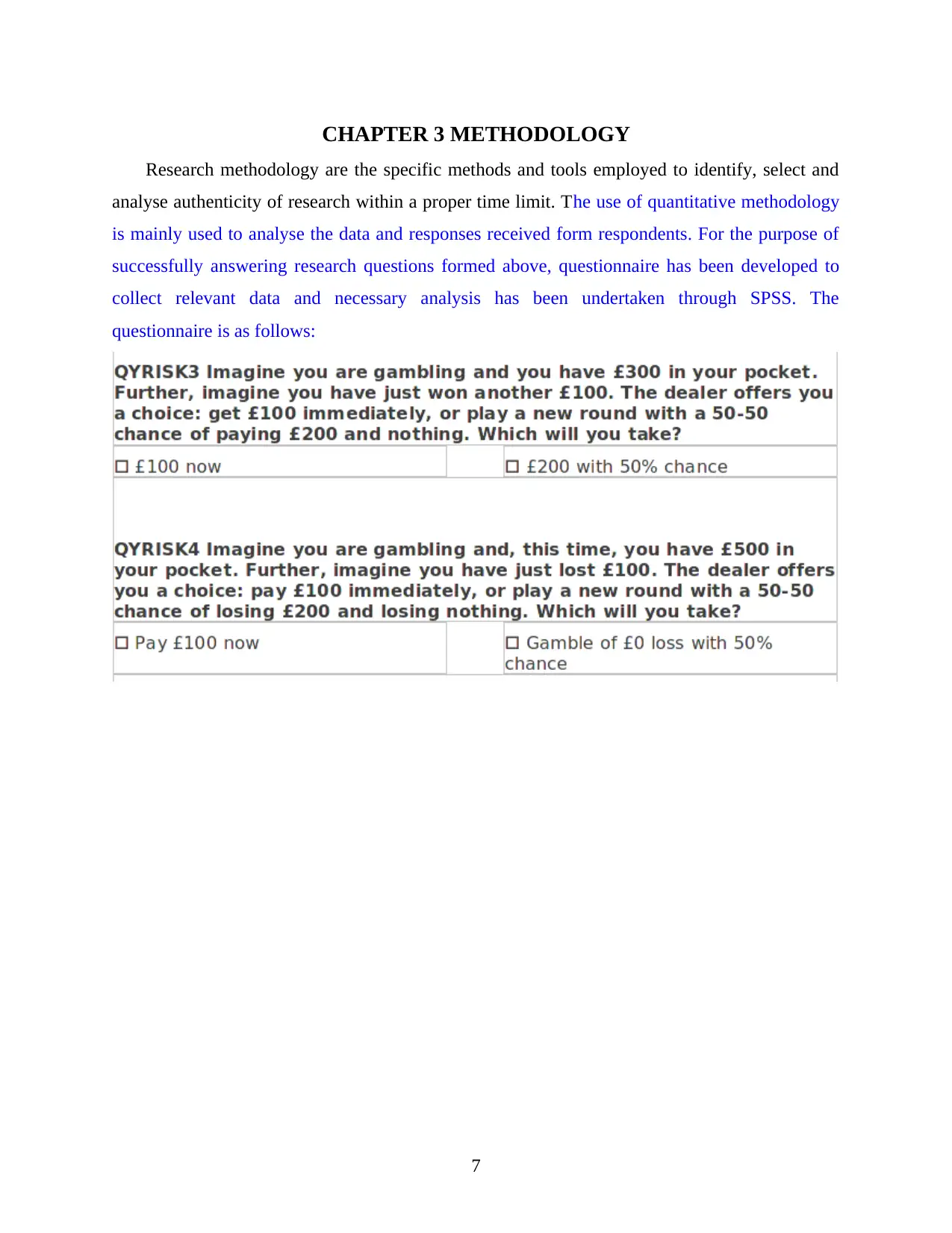
CHAPTER 3 METHODOLOGY
Research methodology are the specific methods and tools employed to identify, select and
analyse authenticity of research within a proper time limit. The use of quantitative methodology
is mainly used to analyse the data and responses received form respondents. For the purpose of
successfully answering research questions formed above, questionnaire has been developed to
collect relevant data and necessary analysis has been undertaken through SPSS. The
questionnaire is as follows:
7
Research methodology are the specific methods and tools employed to identify, select and
analyse authenticity of research within a proper time limit. The use of quantitative methodology
is mainly used to analyse the data and responses received form respondents. For the purpose of
successfully answering research questions formed above, questionnaire has been developed to
collect relevant data and necessary analysis has been undertaken through SPSS. The
questionnaire is as follows:
7
⊘ This is a preview!⊘
Do you want full access?
Subscribe today to unlock all pages.

Trusted by 1+ million students worldwide
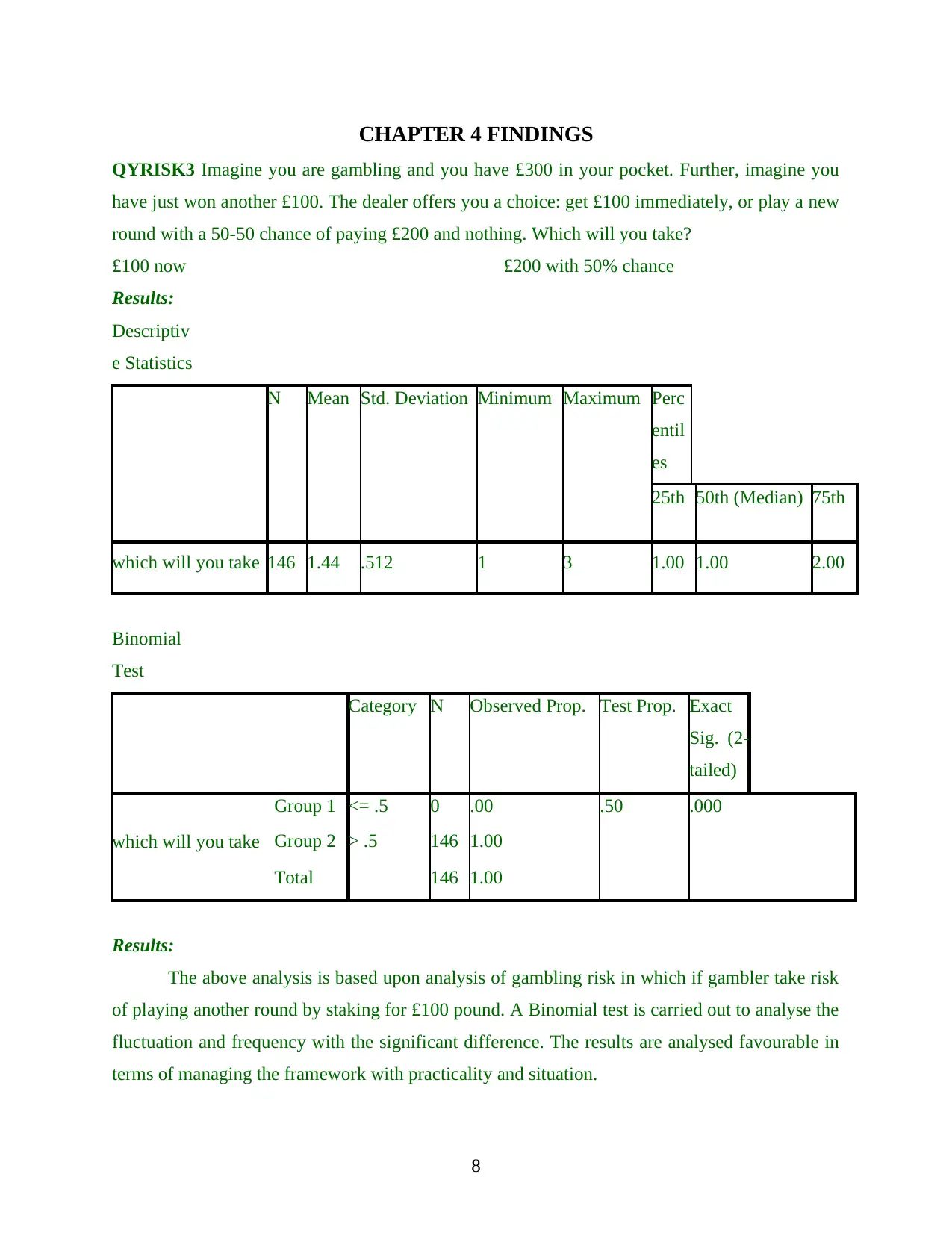
CHAPTER 4 FINDINGS
QYRISK3 Imagine you are gambling and you have £300 in your pocket. Further, imagine you
have just won another £100. The dealer offers you a choice: get £100 immediately, or play a new
round with a 50-50 chance of paying £200 and nothing. Which will you take?
£100 now £200 with 50% chance
Results:
Descriptiv
e Statistics
N Mean Std. Deviation Minimum Maximum Perc
entil
es
25th 50th (Median) 75th
which will you take 146 1.44 .512 1 3 1.00 1.00 2.00
Binomial
Test
Category N Observed Prop. Test Prop. Exact
Sig. (2-
tailed)
which will you take
Group 1 <= .5 0 .00 .50 .000
Group 2 > .5 146 1.00
Total 146 1.00
Results:
The above analysis is based upon analysis of gambling risk in which if gambler take risk
of playing another round by staking for £100 pound. A Binomial test is carried out to analyse the
fluctuation and frequency with the significant difference. The results are analysed favourable in
terms of managing the framework with practicality and situation.
8
QYRISK3 Imagine you are gambling and you have £300 in your pocket. Further, imagine you
have just won another £100. The dealer offers you a choice: get £100 immediately, or play a new
round with a 50-50 chance of paying £200 and nothing. Which will you take?
£100 now £200 with 50% chance
Results:
Descriptiv
e Statistics
N Mean Std. Deviation Minimum Maximum Perc
entil
es
25th 50th (Median) 75th
which will you take 146 1.44 .512 1 3 1.00 1.00 2.00
Binomial
Test
Category N Observed Prop. Test Prop. Exact
Sig. (2-
tailed)
which will you take
Group 1 <= .5 0 .00 .50 .000
Group 2 > .5 146 1.00
Total 146 1.00
Results:
The above analysis is based upon analysis of gambling risk in which if gambler take risk
of playing another round by staking for £100 pound. A Binomial test is carried out to analyse the
fluctuation and frequency with the significant difference. The results are analysed favourable in
terms of managing the framework with practicality and situation.
8
Paraphrase This Document
Need a fresh take? Get an instant paraphrase of this document with our AI Paraphraser
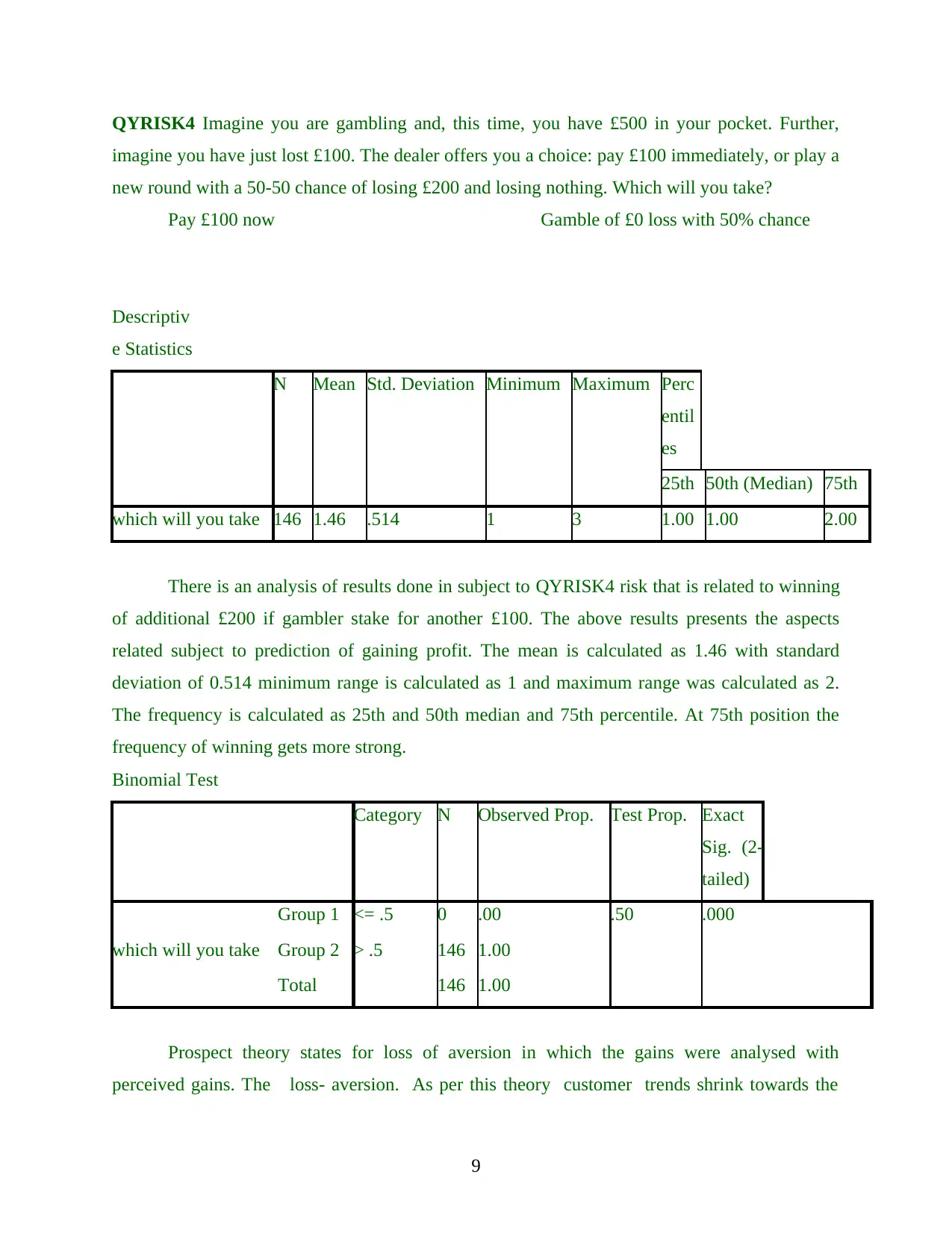
QYRISK4 Imagine you are gambling and, this time, you have £500 in your pocket. Further,
imagine you have just lost £100. The dealer offers you a choice: pay £100 immediately, or play a
new round with a 50-50 chance of losing £200 and losing nothing. Which will you take?
Pay £100 now Gamble of £0 loss with 50% chance
Descriptiv
e Statistics
N Mean Std. Deviation Minimum Maximum Perc
entil
es
25th 50th (Median) 75th
which will you take 146 1.46 .514 1 3 1.00 1.00 2.00
There is an analysis of results done in subject to QYRISK4 risk that is related to winning
of additional £200 if gambler stake for another £100. The above results presents the aspects
related subject to prediction of gaining profit. The mean is calculated as 1.46 with standard
deviation of 0.514 minimum range is calculated as 1 and maximum range was calculated as 2.
The frequency is calculated as 25th and 50th median and 75th percentile. At 75th position the
frequency of winning gets more strong.
Binomial Test
Category N Observed Prop. Test Prop. Exact
Sig. (2-
tailed)
which will you take
Group 1 <= .5 0 .00 .50 .000
Group 2 > .5 146 1.00
Total 146 1.00
Prospect theory states for loss of aversion in which the gains were analysed with
perceived gains. The loss- aversion. As per this theory customer trends shrink towards the
9
imagine you have just lost £100. The dealer offers you a choice: pay £100 immediately, or play a
new round with a 50-50 chance of losing £200 and losing nothing. Which will you take?
Pay £100 now Gamble of £0 loss with 50% chance
Descriptiv
e Statistics
N Mean Std. Deviation Minimum Maximum Perc
entil
es
25th 50th (Median) 75th
which will you take 146 1.46 .514 1 3 1.00 1.00 2.00
There is an analysis of results done in subject to QYRISK4 risk that is related to winning
of additional £200 if gambler stake for another £100. The above results presents the aspects
related subject to prediction of gaining profit. The mean is calculated as 1.46 with standard
deviation of 0.514 minimum range is calculated as 1 and maximum range was calculated as 2.
The frequency is calculated as 25th and 50th median and 75th percentile. At 75th position the
frequency of winning gets more strong.
Binomial Test
Category N Observed Prop. Test Prop. Exact
Sig. (2-
tailed)
which will you take
Group 1 <= .5 0 .00 .50 .000
Group 2 > .5 146 1.00
Total 146 1.00
Prospect theory states for loss of aversion in which the gains were analysed with
perceived gains. The loss- aversion. As per this theory customer trends shrink towards the
9

profitability. In the case where two alternatives are available with same results then it is
evaluated that organisation should compress the changes accordingly. The formation of
viability also remain same and stable.
In the above analysis results are same but with different results. However, there is very
significant difference found in the above analysis as QYRISK3 with significant difference of
0.512 and QYRISK4 with significant difference of 0.514. Gambler should go with the
QYRISK3 because it contains less difference.
10
evaluated that organisation should compress the changes accordingly. The formation of
viability also remain same and stable.
In the above analysis results are same but with different results. However, there is very
significant difference found in the above analysis as QYRISK3 with significant difference of
0.512 and QYRISK4 with significant difference of 0.514. Gambler should go with the
QYRISK3 because it contains less difference.
10
⊘ This is a preview!⊘
Do you want full access?
Subscribe today to unlock all pages.

Trusted by 1+ million students worldwide
1 out of 14
Related Documents
Your All-in-One AI-Powered Toolkit for Academic Success.
+13062052269
info@desklib.com
Available 24*7 on WhatsApp / Email
![[object Object]](/_next/static/media/star-bottom.7253800d.svg)
Unlock your academic potential
Copyright © 2020–2025 A2Z Services. All Rights Reserved. Developed and managed by ZUCOL.





